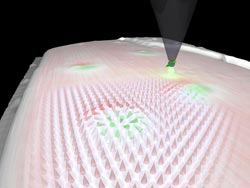Researchers use skyrmions to store information

Figure 1: A skyrmion can be imagined as a two-dimensional magnetic knot, in which the magnetic moments are rotating with unique rotational sense by 360° within a plane. The image shows data from a spin-resolved scanning tunneling microscopy experiment together with a sketch of the sample magnetization.<br><br>Group of R. Wiesendanger, University of Hamburg<br>
Physicists of the University of Hamburg, Germany, managed for the first time to individually write and delete single skyrmions, a knot-like magnetic entity. Such vortex-shaped magnetic structures exhibit unique properties which make them promising candidates for future data storage devices.
Skyrmions have been in the focus of active research for the last years; however, up to now these states have been merely investigated, a controlled manipulation has not been achieved. Now this has been realized by scientists from the group of Prof. Roland Wiesendanger in Hamburg, Germany: as Science Magazine reports online on 08th of August 2013, the creation and annihilation of single skyrmions, corresponding to writing and deleting of information on a storage medium, has been demonstrated by these researchers.
This work solves one of the longstanding technical problems concerning the future use of skyrmions in information technology.
Future electronic devices are expected to become smaller while increasing their data storage capacities at the same time. This will soon bring classical storage technologies to their physical limits. In conventional memory devices used up to now, magnetic bits consist of many atoms with their magnetic moments aligned parallel to each other like bar magnets. Pointing in defined directions, they can represent the values “1” and “0” which are the basis for information technology. With the continuing miniaturization, the interaction between neighboring bits increases due to magnetic stray fields which can lead to loss of data. In addition, small magnetic bits are less stable against thermal fluctuations which is also called the superparamagnetic limit.
Using more “robust” magnetic structures like skyrmions could be a way out of this technological dead end. These structures can be imagined as a two-dimensional knot in which the magnetic moments are rotating about 360° in a plane with a unique rotational sense (see Fig. 1). These particle-like magnetic knots can be assigned a kind of charge, the topological charge. With this it is possible to assign the bit states “1” and “0” to the existence or non-existence of a skyrmion.
A clever choice of temperature and external magnetic field enabled the scientists of the group of Prof. Roland Wiesendanger to prepare and manipulate single magnetic skyrmions for the first time. They used a two atomic layer thick film of palladium and iron on an iridium crystal. In an external magnetic field this sample exhibits single localized skyrmions with a diameter of a few nanometers that can be imaged in a spin-polarized scanning tunneling microscope. Using small currents from the tip of the microscope these skyrmions can be written and deleted. For the creation the previously parallel magnetic moments are twisted to form a knot-like magnetic state, and for the deletion this knot is unwound again.
„We finally found a magnetic system in which we can locally switch between ordinary ferromagnetic order and a complex spin configuration“, says Dr. Kirsten von Bergmann, senior scientist in the Wiesendanger group. As published in the current issue of the Science Magazine, four skyrmions were specifically addressed and could be created and annihilated (Fig. 1). “We transferred the idea of tying a knot to memorize something to the field of storage technology so we can now store data in a two-dimensional magnetic knot”, explains Ph.D. student Niklas Romming.
Whether skyrmions will be used as data storage units in our computers, tablets, or smartphones, is not foreseeable. The experimentally accomplished writing and deleting of skyrmions, however, has demonstrated the feasibility of this technology and paved the way towards a realization of such devices.
Original publication:
Writing and Deleting Single Magnetic Skyrmions,
N. Romming, C. Hanneken, M. Menzel, J. E. Bickel, B. Wolter, K. von Bergmann, A. Kubetzka, and R. Wiesendanger
Science (2013).
Further questions:
Dipl.-Chem. Heiko Fuchs
DFG-Collaborative Research Center 668 and
ERC Advanced Grant Group “FURORE”
Institute of Applied Physics
University of Hamburg
Jungiusstr. 9a
20355 Hamburg, Germany
Phone: +49 – 40 – 42838 – 69 59
e-mail: hfuchs@physnet.uni-hamburg.de
Media Contact
All latest news from the category: Physics and Astronomy
This area deals with the fundamental laws and building blocks of nature and how they interact, the properties and the behavior of matter, and research into space and time and their structures.
innovations-report provides in-depth reports and articles on subjects such as astrophysics, laser technologies, nuclear, quantum, particle and solid-state physics, nanotechnologies, planetary research and findings (Mars, Venus) and developments related to the Hubble Telescope.
Newest articles

Combatting disruptive ‘noise’ in quantum communication
In a significant milestone for quantum communication technology, an experiment has demonstrated how networks can be leveraged to combat disruptive ‘noise’ in quantum communications. The international effort led by researchers…

Stretchable quantum dot display
Intrinsically stretchable quantum dot-based light-emitting diodes achieved record-breaking performance. A team of South Korean scientists led by Professor KIM Dae-Hyeong of the Center for Nanoparticle Research within the Institute for…

Internet can achieve quantum speed with light saved as sound
Researchers at the University of Copenhagen’s Niels Bohr Institute have developed a new way to create quantum memory: A small drum can store data sent with light in its sonic…





















